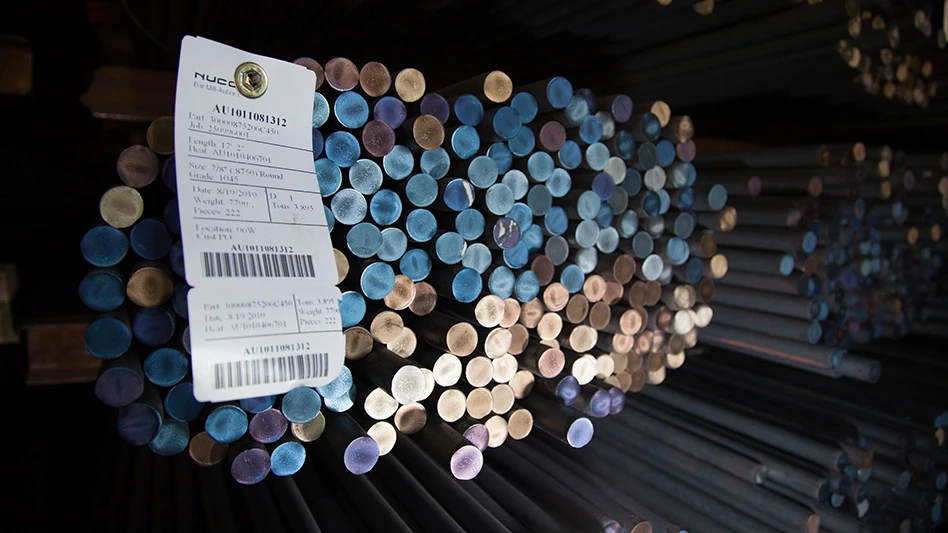
In 2007, the American steel industry employed 161,000 workers and operated at 87 percent capacity utilization. Steel producers cranked out 108 million tons of steel to supply major North American manufacturers the high-quality, performance and strength of steel made by U.S. companies.
Then the Great Recession happened, after which steel companies began to recover slowly, along with much of the manufacturing sector. But in 2012 and again in 2014, tsunamis of imported steel flooded the market.
The imports came from countries that subsidize, or even fully control, their steel industries—leaving American steelmakers to compete against not just other companies but also against foreign governments.
Capacity utilization shrank to as low as 60 percent in 2015, while steel imports captured a record high market share of 29 percent. This is unsustainable.
At the same time, domestic steel production has continued to decline. Year-to-date shipments as of November 2015 stood at 80 million net tons—11.4 percent less than the 90.3 million net tons U.S. steel mills shipped during the same 11 months in 2014.
OUT OF STEP BUT STILL CONNECTED
This surge in imports effectively has decoupled the United States steel industry from the modest growth occurring in the rest of the economy. Nearly 12,000 jobs have been lost in just the past year alone. And nearly 1 out of every 3 tons of steel sold here in 2015 was produced outside the country.
We have seen import surges before, but this time historically high levels of unfairly traded foreign steel are preventing us from seeing a light at the end of the tunnel.
Healthy manufacturing industries create good-paying jobs, generate investment in research and development and produce the critical materials we need for our national defense and export trade. Steel industry plant closures and job losses also affect other dependent industry sectors and ripple throughout the broader economy.
Steel supports almost 1 million jobs in the U.S. economy. One important sector is ferrous scrap. According to the Institute of Scrap Recycling Industries (ISRI), Washington, more than 149,000 jobs are supported by manufacturing and distributing scrap in America.
In a typical year, more than 80 million tons of ferrous scrap are recycled. However, the volume of scrap recycled last year dipped to about 62 million tons in light of decreased production and reduced exports. The import surge has a significant impact on the economics of ferrous recycling and related industries.
The import surge is fueled by the tremendous global overcapacity in steel—in part because of massive subsidization by foreign governments. The Organization for Economic Cooperation and Development (OECD) estimates there are roughly 700 million metric tons of excess steel capacity globally today.
China is by far the largest contributor to this crisis. Its government-owned-and-supported steel industry represents almost half of the world’s steelmaking and more than half of the world’s overcapacity. And the size of the Chinese steel industry continues to grow. Between 2000 and 2014, Chinese steel production increased an amazing 540 percent, while U.S. production actually declined 13 percent.
The outlook today is even worse than during the last major steel crisis that spanned the late 1990s and early 2000s, when unfairly traded imports and other factors produced a wave of bankruptcies and layoffs among American steel companies. Unfortunately, the global steel industry failed to learn from that crisis, and in the years since has continued to develop unneeded capacity at breakneck pace—adding nearly 1 billion tons of crude steel capacity since 2000, with the Chinese steel industry leading the pack.
ACTIONS AND REACTIONS
China’s industrial and trade policies encourage steel production in that country to proceed unabated, even as demand for steel in China has declined for the last two years, causing steel prices to fall and Chinese producers to lose money. To make up for this falling demand at home, China has been shipping out ever-greater quantities of steel at below-market prices. In December 2015, China exported a record 112 million metric tons, up nearly 20 percent from its 2014 record of 94 million metric tons.
But China is not the only source of the surge in steel imports into the U.S. Other major offshore steel suppliers that have seen substantial increases in their volumes to the U.S. market in recent years include Korea and Turkey. This growing surge of imports already has had a devastating effect, driving U.S. plant activity down to the unsustainable levels mentioned previously.
Domestic steel producers are seeking relief by filing trade cases with the U.S. Commerce Department and the International Trade Commission (ITC) on all the major flat-rolled steel products, including corrosion-resistant steel, hot-rolled steel and cold-rolled steel.
Congress gave the Commerce Department new tools last summer when it enacted legislation improving trade remedy laws. It is critical that the department aggressively use them in these cases.
While strong U.S. antidumping (AD) and countervailing duty (CVD) laws provide critical discipline against such unfair trade, fraudulent schemes used by countries to evade AD and CVD orders already put in place have increased.
This negates the remedy that is supposed to be in place for producers who have been found by the ITC to have been injured by unfairly traded imports, and it prolongs the injury to the domestic industry caused by dumped and subsidized imports. As such, it is critical that U.S. Customs and Border Protection (CBP) uses its authority to collect the full amount of AD/CVD duties imposed on these imports and that Congress passes the ENFORCE Act, which will ensure that duties are being accurately assessed and collected at the border.
As a strong North American steel industry is critical across the entire economy, the impacts have a ripple effect across related industries and ecosystems.
Many of the same sources engaging in the practice of dumping also are engaged in some of the worst environmental practices in relation to production.
The American steel industry, however, has been recognized by the U.S. Environmental Protection Agency as having the steepest decline of emissions among manufacturing sectors studied and is dedicated to meeting society’s needs while advancing environmental stewardship.
U.S. manufacturers and their workers can compete with anyone in the world on a level playing field, but they cannot compete against governments. Unless action is taken, and taken soon, it is likely that steel production and the related economic and environmental benefits brought by the U.S. steel industry will continue to decline.

Explore the March 2016 Issue
Check out more from this issue and find your next story to read.
Latest from Recycling Today
- Nippon Steel acknowledges delay in US Steel acquisition attempt
- BASF collaborates to study mechanical plastic recycling
- Commentary: navigating shipping regulations for end-of-life and damaged batteries
- Haber raises $44M to expand to North America
- Canada Plastics Pact releases 2023-24 Impact Report
- Reconomy brands receive platinum ratings from EcoVadis
- Sortera Technologies ‘owning and operating’ aluminum sorting solutions
- IDTechEx sees electric-powered construction equipment growth





